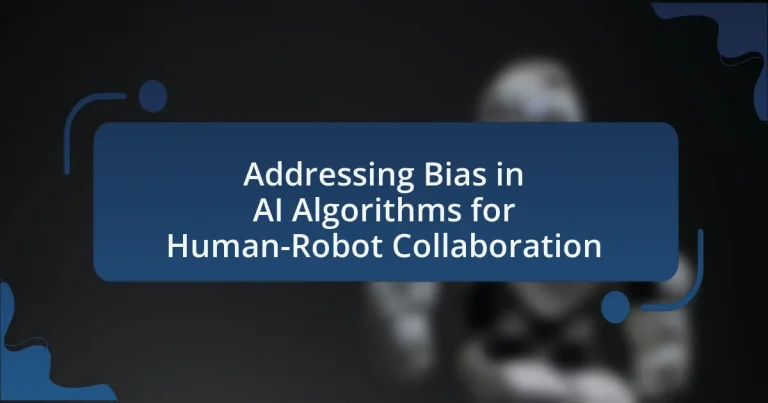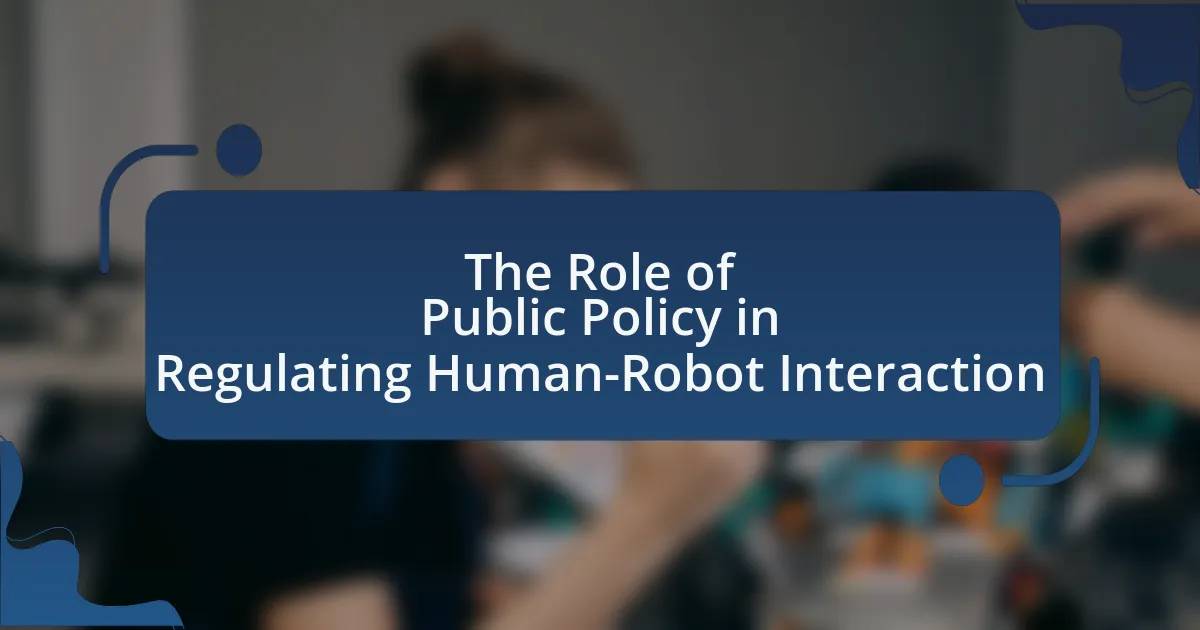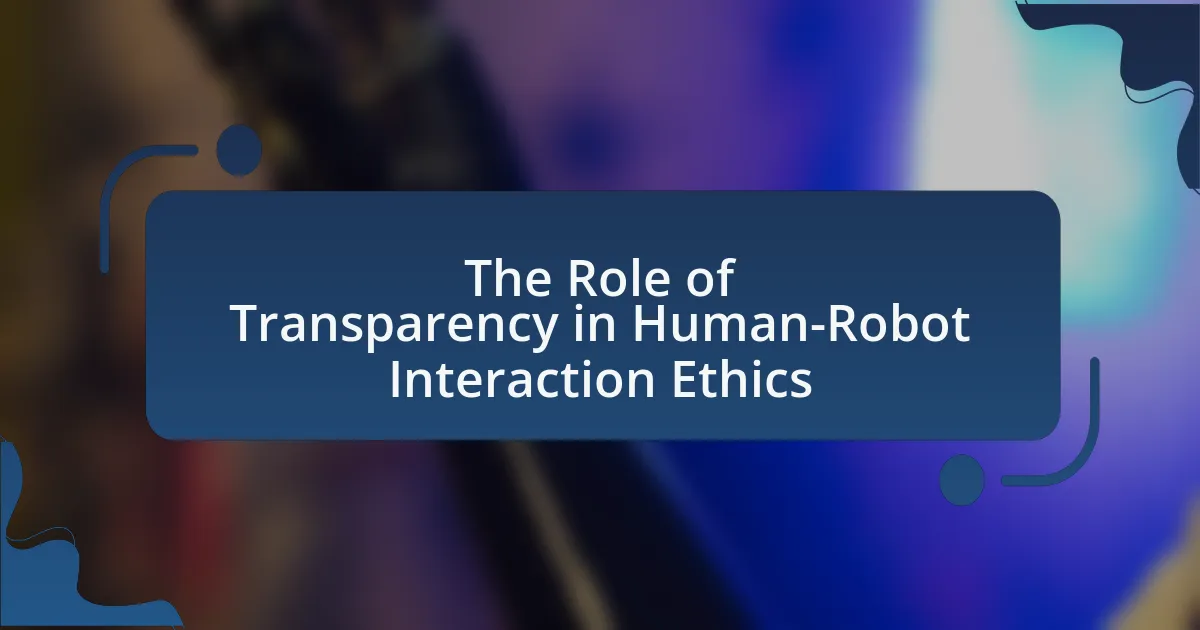Addressing bias in AI algorithms for human-robot collaboration is essential for ensuring fairness and accuracy in interactions between robots and humans. The article explores the various types of biases that can arise, including data bias, algorithmic bias, and societal bias, and their detrimental effects on collaboration. It highlights the importance of diverse training datasets, algorithmic audits, and fairness-aware techniques in mitigating these biases. Additionally, the article discusses the challenges of data quality, algorithmic transparency, and the complexity of human values, while emphasizing the need for interdisciplinary approaches and ethical considerations in AI development to promote equitable outcomes in human-robot interactions.

What is Addressing Bias in AI Algorithms for Human-Robot Collaboration?
Addressing bias in AI algorithms for human-robot collaboration involves identifying and mitigating unfair biases that may affect the performance and interactions of robots with humans. This process is crucial because biased algorithms can lead to unequal treatment of individuals based on race, gender, or other characteristics, ultimately undermining the effectiveness and trustworthiness of robotic systems. Research indicates that biases in training data can propagate into AI models, resulting in skewed decision-making. For instance, a study by Buolamwini and Gebru (2018) highlighted significant disparities in facial recognition accuracy across different demographic groups, emphasizing the need for diverse and representative datasets in training AI systems. By implementing strategies such as algorithmic audits, diverse data collection, and fairness-aware machine learning techniques, developers can work towards creating more equitable AI systems that enhance human-robot collaboration.
Why is addressing bias important in AI algorithms?
Addressing bias in AI algorithms is crucial because it ensures fairness and accuracy in decision-making processes. When AI systems are biased, they can perpetuate and amplify existing inequalities, leading to unfair treatment of individuals based on race, gender, or other characteristics. For instance, a study by ProPublica found that an algorithm used in the criminal justice system was biased against African American defendants, misclassifying them as higher risk compared to white defendants. This highlights the importance of identifying and mitigating bias to promote equitable outcomes in AI applications, particularly in sensitive areas like human-robot collaboration.
What types of biases can occur in AI algorithms?
AI algorithms can exhibit several types of biases, including data bias, algorithmic bias, and societal bias. Data bias occurs when the training data is unrepresentative or skewed, leading to inaccurate predictions or decisions. For example, if an AI system is trained predominantly on data from one demographic group, it may perform poorly for others, as seen in facial recognition technologies that misidentify individuals from underrepresented groups. Algorithmic bias arises from the design of the algorithm itself, which may inadvertently favor certain outcomes over others due to its structure or the assumptions made during development. Societal bias reflects existing prejudices in society that can be perpetuated by AI systems, such as reinforcing stereotypes in hiring algorithms. These biases can significantly impact the effectiveness and fairness of AI applications in human-robot collaboration.
How do biases in AI affect human-robot collaboration?
Biases in AI negatively impact human-robot collaboration by leading to misinterpretations and ineffective interactions. When AI systems are trained on biased data, they may exhibit prejudiced behaviors or make flawed decisions, which can result in robots misunderstanding human intentions or responding inappropriately. For instance, a study by the MIT Media Lab found that facial recognition algorithms misidentified individuals from certain demographic groups, which could hinder trust and cooperation in collaborative tasks. This misalignment can create barriers to effective teamwork, as humans may feel uncomfortable or unsafe working alongside robots that display biased behaviors.
What are the key challenges in addressing bias in AI?
The key challenges in addressing bias in AI include data quality, algorithmic transparency, and the complexity of human values. Data quality is critical because biased training data can lead to biased outcomes; for instance, a study by Buolamwini and Gebru (2018) found that facial recognition systems had higher error rates for darker-skinned individuals due to underrepresentation in training datasets. Algorithmic transparency poses a challenge as many AI systems operate as “black boxes,” making it difficult to understand how decisions are made and to identify sources of bias. Additionally, the complexity of human values complicates bias mitigation, as different stakeholders may have conflicting perspectives on what constitutes fairness. These challenges highlight the need for comprehensive strategies to ensure equitable AI systems.
How do data quality and representation contribute to bias?
Data quality and representation significantly contribute to bias by influencing the accuracy and fairness of AI algorithms. High-quality data that accurately reflects diverse populations can mitigate bias, while poor-quality data, such as incomplete or unrepresentative samples, can lead to skewed outcomes. For instance, a study by Buolamwini and Gebru (2018) demonstrated that facial recognition systems exhibited higher error rates for darker-skinned individuals due to a lack of diverse training data. This highlights how inadequate representation in datasets can perpetuate and amplify biases in AI systems, ultimately affecting their performance in human-robot collaboration scenarios.
What role does algorithm design play in bias mitigation?
Algorithm design plays a crucial role in bias mitigation by enabling the development of algorithms that can identify, reduce, and eliminate biases in data processing and decision-making. Effective algorithm design incorporates techniques such as fairness constraints, adversarial training, and bias detection mechanisms, which help ensure that the outputs of AI systems are equitable across different demographic groups. For instance, research has shown that algorithms designed with fairness-aware principles can significantly reduce disparities in outcomes, as evidenced by studies demonstrating that implementing fairness constraints in machine learning models leads to a measurable decrease in biased predictions.
What strategies can be employed to address bias in AI algorithms?
To address bias in AI algorithms, implementing diverse training datasets is essential. Diverse datasets ensure that the AI learns from a wide range of perspectives and experiences, reducing the likelihood of biased outcomes. Research by Buolamwini and Gebru in the “Gender Shades” project demonstrated that facial recognition systems performed significantly worse on darker-skinned and female faces due to biased training data. Additionally, employing bias detection tools during the development process can help identify and mitigate biases early. Techniques such as algorithmic auditing and fairness constraints can also be integrated to evaluate and adjust the performance of AI systems, ensuring equitable outcomes across different demographic groups.
How can diverse data sets improve AI fairness?
Diverse data sets improve AI fairness by ensuring that algorithms are trained on a wide range of perspectives and experiences, which reduces bias. When AI systems are exposed to varied demographic, cultural, and contextual data, they are less likely to perpetuate stereotypes or make unfair decisions. For instance, a study by Buolamwini and Gebru in 2018 demonstrated that facial recognition systems had significantly higher error rates for darker-skinned individuals and women due to a lack of representation in training data. By incorporating diverse data sets, AI can better understand and serve all user groups, leading to more equitable outcomes in applications such as human-robot collaboration.
What techniques are effective for bias detection and correction?
Effective techniques for bias detection and correction include algorithmic audits, fairness metrics, and adversarial training. Algorithmic audits systematically evaluate AI systems for biased outcomes by analyzing decision-making processes and identifying disparities across different demographic groups. Fairness metrics, such as demographic parity and equal opportunity, quantitatively assess the fairness of predictions made by AI models, ensuring that outcomes are equitable. Adversarial training involves introducing biased data during the training process to help the model learn to recognize and mitigate bias, thus improving its robustness against biased inputs. These techniques have been validated in various studies, demonstrating their effectiveness in reducing bias in AI systems.
How does bias in AI impact the future of human-robot collaboration?
Bias in AI significantly undermines the effectiveness of human-robot collaboration by perpetuating stereotypes and limiting the robots’ ability to interact fairly and accurately with diverse human users. For instance, biased algorithms can lead to robots making decisions that favor certain demographics over others, which can result in unequal treatment in applications such as healthcare, law enforcement, and customer service. Research by the MIT Media Lab found that facial recognition systems misidentified individuals from minority groups at a higher rate, highlighting the potential for robots to reinforce existing societal biases. This bias not only affects the trust and acceptance of robots in society but also hinders the development of inclusive technologies that can effectively serve all users.
What are the potential consequences of unaddressed bias?
Unaddressed bias in AI algorithms can lead to significant negative consequences, including perpetuation of discrimination, reduced trust in technology, and impaired decision-making. For instance, biased algorithms may favor certain demographics over others, resulting in unfair treatment in areas such as hiring, law enforcement, and lending. A study by ProPublica found that a predictive policing algorithm disproportionately targeted minority communities, illustrating how bias can exacerbate social inequalities. Additionally, when users perceive AI systems as biased, their trust diminishes, which can hinder the adoption of beneficial technologies. This lack of trust can ultimately lead to less effective human-robot collaboration, as users may be reluctant to rely on systems that they believe are flawed or unjust.
How can ethical considerations shape AI development?
Ethical considerations can significantly shape AI development by guiding the design and implementation of algorithms to ensure fairness, accountability, and transparency. For instance, incorporating ethical frameworks can help identify and mitigate biases in AI systems, which is crucial for applications in human-robot collaboration where equitable interactions are essential. Research by the AI Now Institute highlights that ethical guidelines can lead to more inclusive datasets and algorithmic processes, ultimately fostering trust and safety in AI technologies.
What best practices can organizations adopt to minimize bias in AI?
Organizations can minimize bias in AI by implementing diverse data collection practices, conducting regular audits, and fostering an inclusive development team. Diverse data collection ensures that AI systems are trained on representative datasets, reducing the risk of biased outcomes. Regular audits, such as those recommended by the AI Now Institute, help identify and rectify biases in algorithms, ensuring ongoing fairness. Additionally, fostering an inclusive development team, as highlighted by research from the Stanford University AI Lab, promotes varied perspectives that can identify potential biases during the design phase. These practices collectively enhance the fairness and reliability of AI systems in human-robot collaboration.
How can continuous monitoring and evaluation help in bias reduction?
Continuous monitoring and evaluation can significantly aid in bias reduction by systematically identifying and addressing biases in AI algorithms. This process allows for the ongoing assessment of algorithm performance against diverse datasets, ensuring that any emerging biases are detected early. For instance, studies have shown that regular audits of AI systems can reveal discrepancies in decision-making across different demographic groups, leading to timely adjustments and refinements. By implementing feedback loops from real-world interactions, organizations can adapt their algorithms to mitigate bias, thereby enhancing fairness and equity in human-robot collaboration.
What role do interdisciplinary teams play in addressing bias?
Interdisciplinary teams play a crucial role in addressing bias by integrating diverse perspectives and expertise to identify and mitigate biases in AI algorithms. These teams, composed of professionals from fields such as computer science, ethics, sociology, and psychology, collaborate to analyze the multifaceted nature of bias, ensuring that algorithms are developed with a comprehensive understanding of societal impacts. Research indicates that diverse teams are more effective in recognizing blind spots and challenging assumptions, which is essential for creating fair and equitable AI systems. For instance, a study published in the Proceedings of the National Academy of Sciences found that diverse teams outperform homogeneous teams in problem-solving tasks, highlighting the importance of varied viewpoints in addressing complex issues like bias in AI.
What are the implications of bias in AI for society at large?
Bias in AI has significant implications for society, including perpetuating inequality and discrimination. When AI systems are trained on biased data, they can reinforce existing societal prejudices, leading to unfair treatment in areas such as hiring, law enforcement, and healthcare. For instance, a study by ProPublica found that a widely used algorithm for predicting recidivism was biased against African American individuals, misclassifying them as higher risk compared to their white counterparts. This not only affects individual lives but also undermines public trust in technology and institutions. Furthermore, biased AI can exacerbate social divides, as marginalized groups may face increased barriers to opportunities and resources, ultimately hindering social progress and cohesion.
How can public awareness and education contribute to bias mitigation?
Public awareness and education can significantly contribute to bias mitigation by fostering understanding and critical thinking about biases in AI algorithms. When individuals are educated about the existence and implications of bias, they are more likely to recognize biased behaviors in technology and advocate for fairness. Research indicates that informed communities can influence policy changes and promote ethical standards in AI development, as seen in initiatives like the Algorithmic Justice League, which raises awareness about algorithmic bias and its societal impacts. Furthermore, educational programs that emphasize diversity and inclusion can empower individuals to challenge stereotypes and biases, leading to more equitable AI systems.
What policies can support ethical AI development?
Policies that can support ethical AI development include establishing regulatory frameworks that mandate transparency in AI algorithms, ensuring accountability for AI outcomes, and promoting diversity in AI development teams. Regulatory frameworks, such as the European Union’s AI Act, require organizations to disclose the data and methodologies used in AI systems, which helps mitigate bias. Accountability measures, like requiring audits of AI systems, ensure that developers are responsible for the impacts of their technologies. Additionally, promoting diversity within development teams can lead to more inclusive AI solutions, as diverse perspectives can identify and address potential biases in algorithms.
What practical steps can organizations take to implement bias mitigation strategies?
Organizations can implement bias mitigation strategies by conducting comprehensive bias audits of their AI systems. These audits involve analyzing data sets for representation and fairness, ensuring diverse training data that reflects various demographics, and employing algorithmic fairness techniques to adjust outputs. For instance, a study by Barocas et al. (2019) highlights the importance of using fairness-aware algorithms to reduce bias in decision-making processes. Additionally, organizations should establish ongoing training programs for employees on bias awareness and ethical AI practices, as continuous education fosters a culture of inclusivity and accountability.




